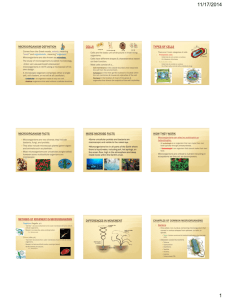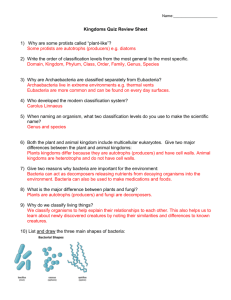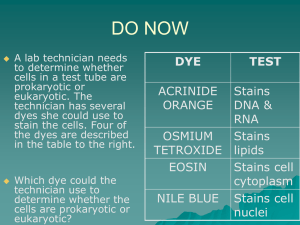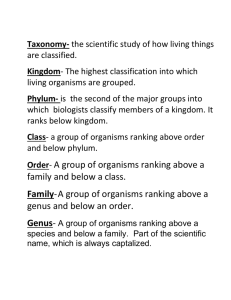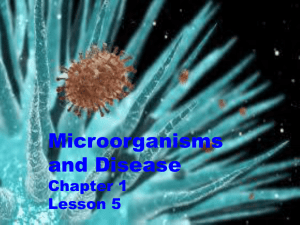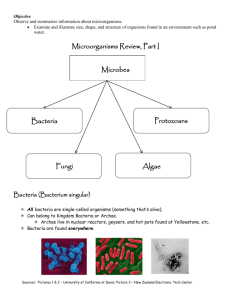Learning Outcomes Sheet for test #21 Name: Unit 4, lessons 1
advertisement
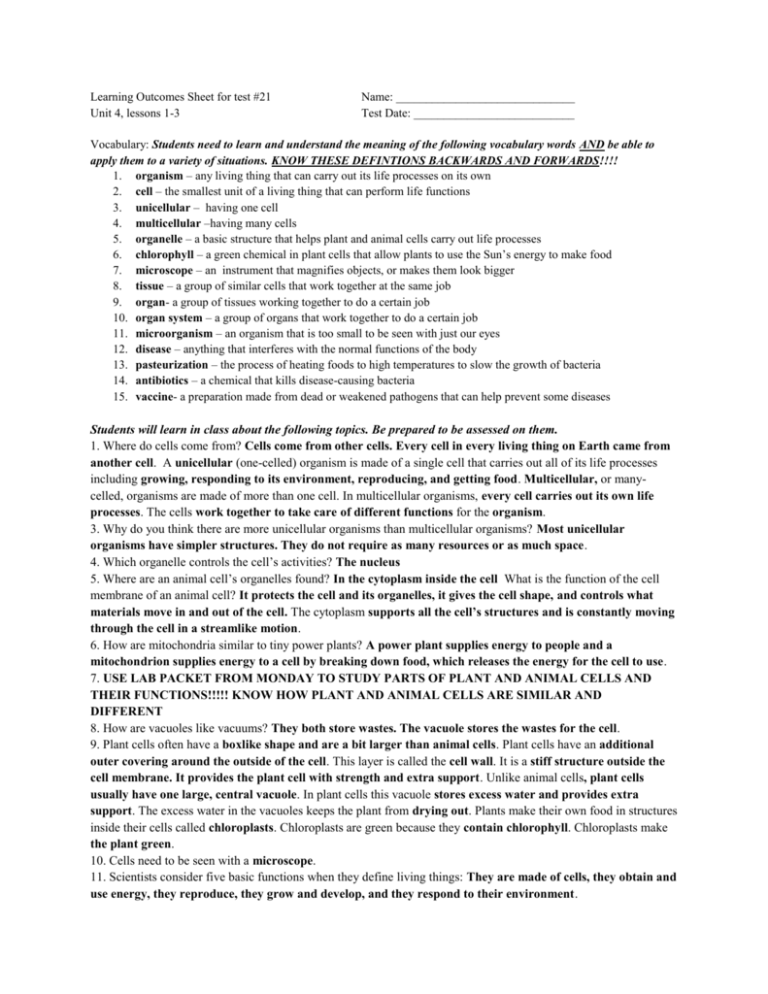
Learning Outcomes Sheet for test #21 Unit 4, lessons 1-3 Name: ______________________________ Test Date: ___________________________ Vocabulary: Students need to learn and understand the meaning of the following vocabulary words AND be able to apply them to a variety of situations. KNOW THESE DEFINTIONS BACKWARDS AND FORWARDS!!!! 1. organism – any living thing that can carry out its life processes on its own 2. cell – the smallest unit of a living thing that can perform life functions 3. unicellular – having one cell 4. multicellular –having many cells 5. organelle – a basic structure that helps plant and animal cells carry out life processes 6. chlorophyll – a green chemical in plant cells that allow plants to use the Sun’s energy to make food 7. microscope – an instrument that magnifies objects, or makes them look bigger 8. tissue – a group of similar cells that work together at the same job 9. organ- a group of tissues working together to do a certain job 10. organ system – a group of organs that work together to do a certain job 11. microorganism – an organism that is too small to be seen with just our eyes 12. disease – anything that interferes with the normal functions of the body 13. pasteurization – the process of heating foods to high temperatures to slow the growth of bacteria 14. antibiotics – a chemical that kills disease-causing bacteria 15. vaccine- a preparation made from dead or weakened pathogens that can help prevent some diseases Students will learn in class about the following topics. Be prepared to be assessed on them. 1. Where do cells come from? Cells come from other cells. Every cell in every living thing on Earth came from another cell. A unicellular (one-celled) organism is made of a single cell that carries out all of its life processes including growing, responding to its environment, reproducing, and getting food. Multicellular, or manycelled, organisms are made of more than one cell. In multicellular organisms, every cell carries out its own life processes. The cells work together to take care of different functions for the organism. 3. Why do you think there are more unicellular organisms than multicellular organisms? Most unicellular organisms have simpler structures. They do not require as many resources or as much space. 4. Which organelle controls the cell’s activities? The nucleus 5. Where are an animal cell’s organelles found? In the cytoplasm inside the cell What is the function of the cell membrane of an animal cell? It protects the cell and its organelles, it gives the cell shape, and controls what materials move in and out of the cell. The cytoplasm supports all the cell’s structures and is constantly moving through the cell in a streamlike motion. 6. How are mitochondria similar to tiny power plants? A power plant supplies energy to people and a mitochondrion supplies energy to a cell by breaking down food, which releases the energy for the cell to use. 7. USE LAB PACKET FROM MONDAY TO STUDY PARTS OF PLANT AND ANIMAL CELLS AND THEIR FUNCTIONS!!!!! KNOW HOW PLANT AND ANIMAL CELLS ARE SIMILAR AND DIFFERENT 8. How are vacuoles like vacuums? They both store wastes. The vacuole stores the wastes for the cell. 9. Plant cells often have a boxlike shape and are a bit larger than animal cells. Plant cells have an additional outer covering around the outside of the cell. This layer is called the cell wall. It is a stiff structure outside the cell membrane. It provides the plant cell with strength and extra support. Unlike animal cells, plant cells usually have one large, central vacuole. In plant cells this vacuole stores excess water and provides extra support. The excess water in the vacuoles keeps the plant from drying out. Plants make their own food in structures inside their cells called chloroplasts. Chloroplasts are green because they contain chlorophyll. Chloroplasts make the plant green. 10. Cells need to be seen with a microscope. 11. Scientists consider five basic functions when they define living things: They are made of cells, they obtain and use energy, they reproduce, they grow and develop, and they respond to their environment. 12. Cars move, age, and use energy. Why are they not living things? Cars do not meet all five criteria of living things. They do not grow and develop, they are not made of cells, and they do not reproduce 13. Cells form tissues, tissues form organs, and organs make up an organ system. Organ systems help carry out an organism’s life processes. 14. Can cells from different organs, like the heart and lungs, be switched? Explain. No, they can’t be switched. The structure is suited to the function. 15. The skeletal system is a support system in animals. Bones make up the skeletal system. Muscles make up the muscular system. The digestive system breaks down food for energy. The brain is part of the nervous system. Lungs are part of the respiratory system. The heart is part of the circulatory system, which transports blood. 16. The root system is a transport system in plants. Stems and leaves are organs of the shoot system. 17. Which organ systems of plants and animals carry out similar functions? The root system in plants and the circulatory system in animals are similar because they both transport materials. 18. What are some common microorganisms? Bacteria, some fungi, some protists Why are microorganisms important? Microscopic organisms provide larger organisms, including people, with some of the food and oxygen they need to survive; some microscopic organisms enrich the environment by breaking down dead organisms. 19. Microorganisms include unicellular and multicellular organisms. What are some examples of unicellular protists and fungi? Unicellular protists: amoeba, paramecium, and Euglena and unicellular fungi: yeast 20. Many diseases are caused by microscopic agents. Some types of bacteria, protists, and fungi can cause diseases. These disease causing agents are called pathogens. Many diseases caused by pathogens can be passed from one organism to another. They are called infectious diseases. 21. Viruses are a type of pathogen that can cause diseases, but they are not considered organisms. They can reproduce, but cannot carry out the four other life functions on their own. 22. Some pathogens are transmitted when a person is in direct contact with an infected individual. Pathogens can also be transmitted through the air or if a person touches a contaminated object. Animals can also pass pathogens to people. 23. One type of bacteria called Streptococcus attacks cells in the throat and causes a disease commonly referred to as strep throat. Some bacteria can also cause disease by producing poisonous substances called toxins. Toxins cause diseases, such as tetanus or scarlet fever. 24. Bacteria can live in uncooked meats, raw eggs, and other foods. E. coli and Salmonella are two of the most well-known. These bacteria attack the digestive system by damaging cells in the intestines and the stomach. 25. Lyme disease is caused when a person is bitten by a tick carrying these bacteria and the bacteria can enter the person’s body. Athlete’s foot is a disease caused by a harmful microscopic fungus that is found in damp places and lives on skin. It can cause flaky skin and itching. Protists can also cause diseases, such as dysentery. It is spread by amoebas that enter an organism’s body by contaminated food or water. 26. Sleeping sickness is caused by a protist that lives in the bodies of cows and other animals and is carried and transferred to humans by flies. Malaria is also caused by a protist. Mosquitos can transmit the protist that causes malaria from one person to another. Once inside the human body, the protist reproduces inside a person’s red blood cells and then destroys them. 27. Microorganisms can also harm plant life. In the 19th century, a protist destroyed large amounts of potato crops throughout Ireland. The disease is known as potato blight. How can farmers avoid another potato famine like the one that occurred in Ireland in the nineteenth century? Today farmers can use chemicals on their crops called pesticides. Pesticides can kill harmful organisms like the one that caused the potato famine. 28. How does the process of pasteurization help keep us safe from disease? Pasteurization destroys harmful bacteria found in foods such as milk. 29. What are some ways to prevent the spread of infectious diseases? Washing your hands and getting vaccinations. The first antibiotic, penicillin, was discovered by Alexander Fleming in 1928. Edward Jenner, in 1796, created the first vaccine – it was for smallpox. In the 1950s, Jonas Salk created a vaccine to prevent polio.



